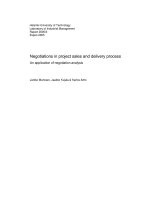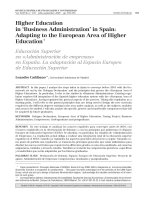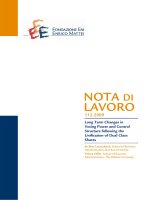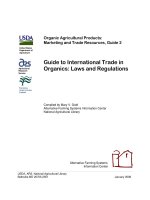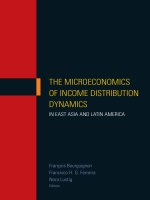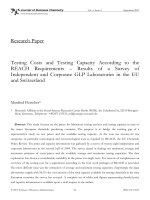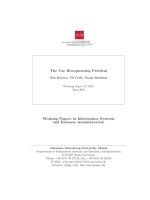Catalonia in spain history and myth
Bạn đang xem bản rút gọn của tài liệu. Xem và tải ngay bản đầy đủ của tài liệu tại đây (8.72 MB, 326 trang )
www.ebook3000.com
Palgrave Studies in Economic
History
Series Editor
Kent Deng
London School of Economics
London, United Kingdom
Palgrave Studies in Economic History is designed to illuminate and
enrich our understanding of economies and economic phenomena of
the past. The series covers a vast range of topics including financial
history, labour history, development economics, commercialisation,
urbanisation, industrialisation, modernisation, globalisation, and
changes in world economic orders.
More information about this series at
/>
www.ebook3000.com
Gabriel Tortella
Catalonia in Spain
History and Myth
Gabriel Tortella
Universidad de Alcalá
Madrid, Spain
Palgrave Studies in Economic History
ISBN 978-3-319-54950-7
DOI 10.1007/978-3-319-54951-4
ISBN 978-3-319-54951-4 (eBook)
Library of Congress Control Number: 2017940633
© The Editor(s) (if applicable) and The Author(s) 2017
This work is subject to copyright. All rights are solely and exclusively licensed by the Publisher, whether
the whole or part of the material is concerned, specifically the rights of translation, reprinting, reuse of
illustrations, recitation, broadcasting, reproduction on microfilms or in any other physical way, and
transmission or information storage and retrieval, electronic adaptation, computer software, or by
similar or dissimilar methodology now known or hereafter developed.
The use of general descriptive names, registered names, trademarks, service marks, etc. in this publication does not imply, even in the absence of a specific statement, that such names are exempt from the
relevant protective laws and regulations and therefore free for general use.
The publisher, the authors and the editors are safe to assume that the advice and information in this
book are believed to be true and accurate at the date of publication. Neither the publisher nor the
authors or the editors give a warranty, express or implied, with respect to the material contained herein
or for any errors or omissions that may have been made. The publisher remains neutral with regard to
jurisdictional claims in published maps and institutional affiliations.
Cover illustration: age fotostock / Alamy Stock Photo
Printed on acid-free paper
This Palgrave Macmillan imprint is published by Springer Nature
The registered company is Springer International Publishing AG
The registered company address is: Gewerbestrasse 11, 6330 Cham, Switzerland
www.ebook3000.com
To
José Luis García Ruiz,
Clara Eugenia Núñez,
Gloria Quiroga,
Who made this book possible
Contents
1 Medieval Origins of the Spanish Nation
The Slow Birth of Spain: One Thousand Years of History
(479–1479)
Medieval Catalonia
Toward Union
The Penultimate Step
Union
Conclusions
References
1
1
5
10
17
21
26
28
2 Catalonia in Early Modern Spain
The Difficult Welding of Two Crowns
The Seventeenth-Century Crisis
A Time of Depression
The War of the Reapers, the First Catalan Rebellion
Recovery
References
29
29
36
36
39
44
48
vii
www.ebook3000.com
viii
Contents
3 Reform and Progress in the Eighteenth Century
The War of Succession, Catalonia’s Second Rebellion
The Nueva Planta: Political, Economic, and Fiscal
Innovations
The Political Nueva Planta
The Fiscal Nueva Planta: The Catastro
The Onset of Catalonia’s Development
Population
Agriculture
Catalonia in the Spanish Empire: Commerce and Industry
Commerce
Industry
Conclusions
References
57
57
58
64
64
65
67
67
69
71
72
4 The Peninsular War: Birth of a Nation
Introduction
Spain’s War of Independence
The ‘War of the French’ in Catalonia
Conclusions
References
75
75
77
81
84
85
5 Liberalism and Reaction
Economic Stagnation and Political Paralysis
A Growing Gap
Reactionary Catalonia: The Carlist Wars
The Slow Establishment of the Liberal System
Catalonia’s Political Weight
The Beginnings of Industrialization
Slow Recovery
The Rhetoric and the Cost of Protectionism
The Catalan ‘Renaissance’
Nationalism and the 1898 Crisis
Conclusions
References
49
49
87
87
87
89
94
102
114
114
120
125
130
133
136
Contents
ix
6 The Twentieth Century (1900–1975)
Spain in the Twentieth-Century Crisis
Catalanism in the Happy Twenties
The Lliga: Catalanists in the Spanish Government
Catalanism and the Primo de Rivera Dictatorship
The Second Republic
The Catalan Statute of Autonomy
From Revolution to Civil War
The Civil War
Postwar Repression
Economic Stabilization and Development
Politics in the Twilight of Fascism
Economic Development in Spain and Catalonia
Industrialization and State Intervention
The Problems of Catalan Banks
Commercial and Fiscal Balances: The Early Studies
Conclusions
References
139
139
147
147
152
157
157
160
165
171
175
175
178
179
181
183
184
187
7 From Dictatorship to Democracy
Introduction
Transition to Democracy
Is Still Catalonia ‘The Factory of Spain?
Crisis and Change in the Spanish Economy
The Catalan Economy at the Turn of the Century
The Generalitat in Action
First Steps
The 1979 Estatut: The Beginnings of Enforced
Catalanization
The Banca Catalana Affair
Success and Failure of a Coercive Linguistic Policy
Controlling the means of Communication
The Catalan Population
The Education Policy of the Generalitat
The Social Support for Independence
189
189
192
202
202
206
207
207
www.ebook3000.com
209
214
227
233
236
241
258
x
Contents
Some Hotly Debated Issues
Fiscal Balances
Commercial Balances
Political Consequences of Separation
References
263
263
267
270
277
8 Conclusions
The Weight of History
Nation and Nationalism
The Causes of Catalan Nationalism
Why Now?
References
279
279
282
287
289
296
Bibliography
299
Index
303
List of Figures
Fig. 3.1
Fig. 5.1
Fig. 6.1
Fig. 7.1
Fig. 8.1
Equivalente of Aragon and Rentas Provinciales (of Castile)
as a Percentage of Total Revenue
Extra Cost due to Price Differential between Catalan
and English Textiles s (% of GNP)
Catalan GDP Relative to Spanish GDP (1800–2000)
(Spanish GDP = 100)
The Iberian Peninsula in the Fifteenth Century
Income (GDP) per capita. Catalonia, Spain and European
Union, 2000–2012
62
124
148
228
295
xi
www.ebook3000.com
Map 1 Spain and its Regions (Autonomous Communities)
Introduction
Catalan separatism is the number one political problem that Spain faces
today. The problem has become more serious after the ‘Brexit.’ The
possibility of disintegration of the Union has markedly increased after a
member as important as the United Kingdom has decided to quit. The
history of Catalonia in its relation with the rest of Spain, therefore,
should be of interest not only to Spaniards but also to non-Spaniards,
especially to citizens of the EU.
Catalan separatism is the number one political problem that Spain
faces today. It is far from a bilateral question, however. The problem
affects the European Union (EU) as a whole and also some of its
individual members, France especially. For the EU, the secession of a
part of one member state is a problem in any case. The Union is the
consequence of a long, difficult, and unfinished process of integration,
and the disintegration of a part of one of its members would pose serious
questions, for several reasons, among others because one of the Union’s
expressed premises is respect of the territorial integrity of its member
states. The Treaty of the EU, however, foresees the eventuality of the
separation of a region and its immediate consequence is that this region
automatically ceases to be a part of the Union. It is obvious that the
Union considers such eventuality with disquiet, chiefly because other
regions might want to follow the example of the leaver.
xiii
www.ebook3000.com
xiv
Introduction
The problem has become more serious after the ‘Brexit.’ The possibility of disintegration of the Union has markedly increased after a
member as important as the United Kingdom has decided to quit. If
after the United Kingdom leaves the Union, Catalonia should split from
Spain, thereby leaving the Union too, the whole European edifice would
be under threat of dissolution or at least of considerable shrinkage. Even
though Catalonia is much smaller (its population is less than 1.7 percent
of the EU population, excluding the United Kingdom), its leaving the
EU after the United Kingdom would be extremely ominous.
The history of Catalonia in its relation with the rest of Spain, therefore, should be of interest not only to Spaniards, but also to nonSpaniards, especially to citizens of the EU. The most directly affected
country should be France, because Catalan separatism has a strong
imperialistic component. Catalan nationalists like to speak of the països
Catalans (Catalan countries), referring to regions where Catalan is
spoken and/or used to belong to the old kingdom of Aragon. This
includes Valencia, the Balearic Islands, part of eastern Aragon, and the
Roussillon, a region north of the Pyrenees which used to be part of
Catalonia until the French conquered it during the War of the Reapers
(see Ch. 2). Catalan nationalists think that these territories should have
the right of self-determination, just as Catalonia has, according to their
views. This right of self-determination means that these territories have
the right to abandon their present status and elect to join a ‘Grand
Catalonia,’ whose nucleus would be, of course, an independent
Catalonia. The Catalan Parlament recently (October 2016) approved a
declaration to this effect, something which immediately provoked a
protest of the French government to the Spanish ambassador in Paris.
The basis of the present book is a Spanish version which was published in
January 2016 by myself and three more coauthors, José Luis García Ruiz,
Clara Eugenia Núñez, and Gloria Quiroga, to whom this English version is
dedicated. The Spanish version was sponsored by the Foundation Alfonso
Martín Escudero and by the Colegio Libre de Eméritos and published by
Editorial Gadir. The former considerations about the international dimensions of the Catalan conflict made me seriously think about producing an
English version of the book and even before it was finished, I contacted my
friends at Palgrave Macmillan suggesting the possibility of carrying out my
Introduction
xv
idea. The present book is a little more compact than the Spanish version; I
have eliminated part of the scholarly apparatus and shortened the bibliographical appendix. Facts and reasoning presented, however, are exactly those of
the Spanish version. And, of course, more recent events have been taken into
account in the present version.
An additional reflection weighed in my mind. My conversations with
English and American friends, plus my readings of books, journals, and
magazines made me see that opinion in Anglo-Saxon countries was (and is)
slanted in favor of Catalan independence. One reason for this, I am sure, is
the memory of the Franco dictatorship with its ferocious centralism and
ruthless suppression of dissenting opinion; as happened within Spain, the
liberal and enlightened opinion sympathized with Catalans and Basques as
oppressed peoples under the boot of the military dictator. By and large, I
agree with this view; but things have changed, and the oppressed have
become oppressors, not manu military, but through a ‘white dictatorship,’
as Josep Tarradellas, the first Catalan president in democratic, post-Franco
Spain, predicted. One of the aims of this book is to show how this ‘white
dictatorship’ works. Unfortunately, there are in the world today abundant
examples of those mixtures of oligarchical government with elections, so the
reader will not be surprised or consider the Catalan case a rarity.
Another, related, perception is that publications in English about Catalan
modern history are slanted in the same way. This not only the case with
Allison Peers, who wrote in the 1930s and whose sympathies for the
Republicans extended to the ‘Catalan nation.’ Peers was too serious an
academic not to also see the flaws, if not of Catalan nationalism, of some
Catalan nationalists. But many of the more modern books that circulate in
English about Catalonia are less scholarly and more slanted than Peers’s
Catalonia Infelix was. Here are two examples I recently came across: Simon
Harris, Catalonia is not Spain and Liz Castro, What’s up with Catalonia. ¿Qué
le pasa a Cataluña? Harris’s book title says it all; Castro’s book is really a
propaganda piece by the generalitat of Artur Mas. I have been unable to find
equivalent books in English trying to present a non-nationalist-separatist
standpoint. This is what Catalonia in Spain tries to do.
I have contracted many debts while writing this book. First of all, with
those institutions I mentioned in the first paragraph and the persons heading
them, Ramón Parada Vázquez and Elisa Polanco of the Foundation, Juan
www.ebook3000.com
xvi
Introduction
Torres and Álvaro Delgado-Gal of the Colegio, and Javier Santillán of Gadir.
Professor Parada and the Foundation he presides were kind enough to cede
their publication rights in English. When carrying out our research for the
Spanish book, we were aided by numerous persons and institutions which are
mentioned in the Introduction to that book. While working on the English
version, I was kindly aided by my coauthors in the Spanish version in many
ways which it would be long to detail here. Javier Santillán also has made
valuable contributions. Luis Múzquiz, of GeaCron, has made a map for me
(no. 2) and generously ceded his copyright. I also want to thank Palgrave, and
especially Aimee Dibbens and Thomas Coughlan, for their assistance with
the production of the book.
Madrid, November 2016
1
Medieval Origins of the Spanish Nation
The Slow Birth of Spain: One Thousand Years
of History (479–1479)
Modern Spain occupies about 84 percent of the Iberian Peninsula’s
surface (the rest is occupied by Portugal); it encompasses also the
Balearic Islands, the Canary Islands, plus two nearby north-African
cities, Ceuta and Melilla, plus a few minor islands and islets in the
Mediterranean between Spain and Morocco. The Iberian Peninsula is
very mountainous, and its rivers are scarcely navigable. Except for the
northern coast, Spain is a sunny, dry country, with wide semi-desertic
areas.
The Peninsula has been inhabited since pre-historic times by a variety
of peoples (Iberians, Celts, and others). Greeks, Phoenicians, and
Carthaginians established coastal colonies, but the Romans conquered
it almost in its entirety, and divided it into five provinces. When the
Roman Empire fell, the Peninsula became unified under the Visigothic
kingdom, which adopted Roman Christianity. The Muslim invasion
and conquest, starting in 711, put the Peninsula under the rule of the
© The Author(s) 2017
G. Tortella, Catalonia in Spain, Palgrave Studies in Economic
History, DOI 10.1007/978-3-319-54951-4_1
www.ebook3000.com
1
2
1 Medieval Origins of the Spanish Nation
Emirate (later Caliphate) of Córdoba, which encompassed the whole of
the Peninsula except for the northern mountainous areas: the
Cantabrian Mountains and the Pyrenees, where small Christian counties
and kingdoms survived. Around the year 1000 the tables turned: the
Caliphate collapsed and was replaced by a number of smaller Muslim
kingdoms (called taifas by the Christians, from the Arab word meaning
‘band’), while the Christian kingdoms started expanding toward the
south at the expense of the taifas in a centuries-long process commonly
called the Reconquista (re-conquest). The Reconquista ended in the
fifteenth century when the last Muslim kingdom in Spain, Granada,
surrendered, and the whole of the Peninsula was left in Christian hands
under two kingdoms, Spain (including Navarre) and Portugal.
Geographical factors explain the strength and variety of the
Peninsula’s regions, the multiplicity of its languages, customs, and
identities. Transportation and communication have been difficult in
the past due to high mountain chains and non-navigable rivers.
However, there were also factors favoring unity: the Pyrenean
Mountains, a barrier separating the Peninsula from the rest of Europe,
turned it almost into an island. The massive, compact Peninsula has
been designated with the name Hispania (also Iberia) since Roman times
at least. Aside from relative geographical isolation, two historical factors
fostered unity: Christianity and the memory of the Visigothic kingdom.
The Latin language must also have contributed to give cohesion to
Christian Spain. Although Latin gradually evolved into a series of
dialects, in the late Middle Ages Castilian Spanish had become the
most widely spoken language, and it acquired the character of lingua
franca. The other two significant Latin dialects or languages were
Galaico-Portuguese in the west and Catalan in the east. The Basque
language, of uncertain origin, was spoken in the Basque country, straddling the Pyrenees.
Another unifying element was the Reconquista itself: taking the
lands from the Muslims was justified in the name of religion and by
the fact that these territories had belonged to the Visigothic kingdom. But in reality the Reconquista was part of a European-wide
phenomenon. In the late Middle Ages Europe expanded in several
directions: to the east at the expense of the Slavs and to the south
The Slow Birth of Spain: One Thousand Years of History (479–1479)
3
and west at the expense of the Muslims. The most noted episode of
this European expansion was, of course, the Crusades in the Middle
East. Many Spaniards thought the Reconquista to be part of the
crusading movement. This was a period when many peoples from
northern Europe, especially Frenchmen, crossed the Pyrenees, some
as pilgrims to visit the shrine of Saint James (Santiago) in
Compostela, others to establish themselves in the lands taken from
the Muslims. The participation of ‘foreign peoples’ in crucial battles
of the Reconquista (Englishmen in the conquest of Lisbon,
Frenchmen at the Navas de Tolosa – the decisive battle which
opened the Andalusian plains to the Christian armies in 1212) was
widely acknowledged. Alfonso VI, the conqueror of Toledo in 1085,
had married his two daughters to Frenchmen. One of these, Henry
of Burgundy, became count of Portugal, originally a dependency of
the kingdom of Galicia. Henry’s son, Afonso Henriques, became the
founder of the Portuguese kingdom.
A clear manifestation of this unifying trend was the merging of
Asturias, Galicia, León, and Castile into a single kingdom de facto
under Alfonso VI. The youngest of these realms, Castile, became the
most powerful and in the end gave its name to the whole unified
kingdom. The three Basque counties south of the Pyrenes, Biscay,
Guipúzcoa, and Álava, voluntarily joined Castile in the twelfth, thirteenth, and fourteenth centuries, respectively. A similar phenomenon
was taking place in the east: several Pyrenean counties united to form the
kingdom of Aragon in 1035 under king Ramiro I. To the west of
Aragon, the kingdom of Navarre remained independent until the sixteenth century, while to the east a group of Pyrenean counties were
loosely united under the count of Barcelona into what was to become
Catalonia. The Pyrenean counties, western (Aragon) and eastern
(Catalonia), originally belonged to the Carolingian empire and were
collectively known as the Marca Hispanica (Hispanic March or Mark),
a fortified territory guarding the imperial frontier from the Muslims to
the south. The Carolingian empire had similar fortified territories in the
North (Danemark) and the East (Ostmark). These Pyrenean counties
gradually severed their ties with the French and coalesced into Aragon
and Catalonia.
www.ebook3000.com
4
1 Medieval Origins of the Spanish Nation
As a consequence of these unifying trends, the Peninsula was divided
into five separate kingdoms at the end of the Middle Ages: Portugal to
the west, Castile in the center, and Aragon to the east. Navarre was
pressed between Castile and Aragon, and, to the south, Granada was the
only remaining Muslim kingdom. Portugal had been a single unit from
its origins, but Castile and Aragon were the results of the accretion of
diverse political units: the crown of Castile comprised Asturias, León,
Galicia, plus several former taifa kingdoms such as Toledo, Seville,
Córdoba, and others, the Basque counties and of course Castile itself.
The crown of Aragon comprised Catalonia, plus the former Muslim
kingdoms of Mallorca and Valencia, plus the kingdom Aragon itself.
Granada and Navarre were conquered and added to Castile in 1492 and
1512, respectively. A little earlier it was evident that Castile, being the
largest and most powerful of the three major kingdoms, and centrally
located, would absorb at least one of its neighbors, if not both; it
eventually absorbed both. The earlier and more lasting union was that
with Aragon, which took place largely through the decision of Isabel of
Trastámara, soon to become queen of Castile, who in 1469 preferred
marrying her cousin Fernando, son of the king of Aragon, rather than
Afonso V, king of Portugal.
This is the period (late fifteenth century) when, after long and often
bloody vicissitudes, the earliest large kingdoms of Western Europe
(Portugal, Spain, France, England, and Scotland) were formed and
initiated their long process toward becoming modern nations. Soon
other kingdoms (Sweden, for instance) would follow the same path
toward nationhood. After five centuries of rivalries and wars, the
European nations undertook the road toward unity, a road they are
still engaged on. The European Unión is a reality today, but its future is
not as clear and assured as one would desire.
In a recent book on the history of Catalonia, the nationalist historian
Josep Fontana (2014) states that ‘identity’ (he is referring to Catalan
identity) is something born out of a long shared coexistence, but
historically this coexistence is not limited to Catalonia. The truth is
that Catalonia has been part and parcel of Spain (or Hispania) at least
since Antiquity. The land which is Catalonia today was a part of a
Roman province (Tarraconensis), one of the five which formed Roman
Medieval Catalonia
5
Hispania (the others were Carthaginensis, Baetica, Lusitania, and
Gallaecia); it later became part of the Visigothic kingdom; after
the demise of the Goths and the Muslim invasion, it was part of
the Caliphate, except for the Pyrenean counties, which were part of
the Carolingian empire (Marca Hispanica). First as Carolingian
suzerainties, later on more or less on their own, these counties
engaged in the Reconquista as other Christian Hispanic counties
and kingdoms did; then the nascent Catalonia became part of the
crown of Aragon, which in turn would merge with Castile to form
Spain.
This gradual process of formation of the Spanish nation by gradual
accretion of former smaller political units was not unique; it took place
in a parallel way in other future nations, such as France and England
(and then Britain). In Spain, however, it was a little different in that it
proceeded pari passu with the Reconquista and the consequent process of
repopulation. But during all this formative medieval period the history
of Catalonia conforms in its broad contours to that of the kingdoms of
the rest of Spain.
Medieval Catalonia
The history of Catalonia during the Middle Ages turns around five great
topics: 1) The Reconquista, 2) The association, and then enmity, with
France, 3) The relation of cooperation and rivalry with Castile, 4) The
union with Aragon, and 5) Its seafaring activities and its interest in the
Mediterranean where it created an empire which was the cause and the
consequence of its commercial activity.
Catalan seafaring and commercial activities were already paramount
in Antiquity, when Greek sailors founded the fabled port of Emporion
(today’s Ampurias, or Empuries in Catalan). Phoenicians and
Carthaginians also founded colonies in the area. One tradition says
that Barcelona was founded by Hamilcar Barca, father of Hannibal,
and that its original name, Barcino, referred to this powerful Cartaginian
family. It certainly was re-founded by the Romans, but the main
‘Catalan’ port at that time was Tarraco (today’s Tarragona), capital of
www.ebook3000.com
6
1 Medieval Origins of the Spanish Nation
the Tarraconensis province. By the late Roman Empire Catalonia and the
rest of Hispania’s Mediterranean area was pre-dominantly Christian.
Even before the fall of the Empire in 479, Hispania was exposed to
the invasions and incursions of the Barbarian peoples. From 411 on
Vandals, Suevi, and Alans crossed the Pyrenees and established themselves. Vandals and Alans traversed the Peninsula, and many also crossed
the Gibraltar strait and invaded northern Africa. The Suevi established
themselves in Galicia and northern Portugal and created a kingdom
there. But those who left a longer and deeper imprint were the Visigoths,
Germanic as the most of the other barbarians, but semi-civilized after a
long stay in the eastern part of the Empire. They entered Spain through
Catalonia, occupied Barcino and Tarraco, and established their royal
court in both cities successively and momentarily. After being defeated
by the Franks at Vouillé in 507, the Visigoths vacated France, occupied
most of Hispania, and made Toledo the capital of the HispanoVisigothic kingdom. The Goths were a minority in the Peninsula, and
practiced a version of Christianity called Arianism; the pre-dominant
Hispano-Roman population was orthodox Roman. Later the Visigoths
officially adopted the religion of the majority, but this caused a split
among their governing elite and contributed to the downfall of their
kingdom and the invasion of the Muslims from northern Africa in 711.
Most of Hispania fell to the Muslims, who went on into France only to
be defeated by the Franks at Poitiers (732). They then fell back into
Hispania, which they called Al-Andalus. Initially, Muslim Spain was but
a province of the gigantic Umayyad Caliphate of Damascus, ranging all
the way from Syria to the Atlantic Ocean along the southern shore of the
Mediterranean. However, the Umayyad dynasty was deposed, and its
descendants moved to Spain, where they established an independent
emirate in 750, with Córdoba as its capital. The Umayyads ruled
Muslim Spain for two and a half centuries; in 929 the emir AbdelRahman III proclaimed himself Caliph; under him and his immediate
successors, the Cordoba Caliphate became one of the richest and most
cultivated of medieval kingdoms, but in 1002 it disintegrated into the
taifa kingdoms. The last leader of the Caliphate was not a caliph, but a
warlord commonly called Almanzor (from Al-Mansur, the Victorious in
Arabic), who in 981 became an all-powerful hajib (sort of prime
Medieval Catalonia
7
minister), a post he held until his death in 1002. For twenty years
Almanzor fought and terrorized the Christian kingdoms, capturing
and pillaging their cities, from Compostela to Barcelona. It can be fairly
said that he was the last Muslim overlord in Spain. After his death the
Caliphate broke down, the Christians took the initiative, and the
Reconquista started in earnest.
The Muslims never occupied the Peninsula in its entirety. The northern mountain chains (the Pyrenees and the Cantabrian mountains)
sheltered a host of Christian statelets or counties, later kingdoms,
which the Muslim emirate never could dislodge. While the Pyrenean
counties became attached to the Frankish empire, the western counties
and kingdoms (of which Asturias was the most important) were independent and comprised a mixture of Goths and Hispano-Romans who
had fled the Muslims, with peoples of local origins (Cantabrians,
Asturians, Basques) who had largely escaped Roman influence and
who now converted to Christianity and learned Latin from the southern
newcomers. These new kingdoms started inching southward toward the
plains which lay between the Duero river and the mountains. Thus in
856 the city of León, on the southern slopes of the Cantabrian mountains, became the capital of the new kingdom of León. This slow
southward movement accelerated perceptibly after the fall of the
Caliphate. Two symbolic events were the conquest of Toledo by
Alfonso VI (1085) and of Valencia by the Cid (Rodrigo Díaz de
Vivar, a Castilian warlord) in 1094, although this city fell to the
Muslims again after the death of its Christian conqueror.
In eastern Spain the Reconquest proceed more slowly due in part to
rivalries and dissensions among the Christian counties and between
them and the Carolingians. The easternmost counties were quite numerous (around 12) although Barcelona soon became paramount and
absorbed most of the others. Hence the term Principado (Principality;
Principat in Catalan), which is often used to designate Catalonia:
the count of Barcelona was considered as the principal (prince) of
the Catalan counts. Perhaps for this reason Catalonia never acquired
the rank of kingdom. The semi-legendary founder of this budding
Catalonia avant-la-lettre was Guifre el Pilós (Wilfred the Hairy) who
was count of Barcelona and made his son his heir, something which
www.ebook3000.com
8
1 Medieval Origins of the Spanish Nation
entailed some degree of independence, since up to then the counts had
been appointed by the Frankish authorities. Legend has it that the French
king Charles the Bald, who had made Guifre count, created the Catalan
ensign (four red stripes over a yellow background) when, attending a
wounded Guifre after a battle against the Muslims, he dipped his fingers
in his count’s blood and drew four red stripes over a golden shield. In
reality the ensign was not used until several centuries later.
What is true, however, is that Guifre founded the Barcelona dynasty,
and that he and his immediate descendants took advantage of the
weakness of the Frankish kingdom. This relative independence was
aided, paradoxically, by the destruction of Barcelona by Almanzor,
which demonstrated the inability of the French overlords to defend it
or at least help in its reconstruction. At this time (eleventh century) as in
the rest of Christian Spain, population grew, to which immigration from
France contributed, and the economy showed some vigor. Agriculture
prospered and even some technical progress took place (water mills).
Counties issued money and commerce developed.
This relative prosperity fostered rivalries and hostilities among the
counties; the Church tried to foster peace and created assemblies of
‘peace and truce’ (pau i treva in Catalan), which met often to reduce
violence and which, in the long run, became the embryo of the
future Corts (Catalan Parliament), when the counts turned these
assemblies into instruments for the collection of taxes. One of the
early counts of Barcelona, Ramon Berenguer I, published the Usatges
de Barcelona (Customs or Uses of Barcelona), the first legislative text
written in Catalan.
Historians have written about the fet diferencial (Catalan for ‘differential fact or trait’), meaning that Catalonia was and is different from the
rest of Spain. The phrase was coined in the twentieth century, in the
apogee of nationalism, and its validity is dubious. As we have seen,
regional differences are strong in Spain for geographical and historical
reasons, and some regions can claim differential factors as strong as
Catalonia. Referring to medieval times, the main Catalan fet diferencial
would be that, due to French influence, feudalism would have been
much stronger there than in the rest of Spain, where seignioralism, a
diluted form of feudalism, prevailed due to the fact that in frontier
Medieval Catalonia
9
territories vassals enjoyed more independence, and social mobility was
greater than in more self-contained societies. But Pierre Vilar (1962, I,
pp. 377–392), a noted French hispanist and author of a monumental
history of early modern Catalonia, points out that southern Catalonia
was also a frontier territory, and that its social structures were, with very
minor differences, more similar to those of Castile than to those of
northern (‘old’) Catalonia, while the institutions of old Catalonia have
more similarities with those of León, Asturias, and Old Castile.
The Reconquista brought about cooperation between different
Christian kingdoms, buy also rivalry. We saw that the Cid conquered
Valencia, up to then a Muslim kingdom which the counts of Barcelona
considered within their area of influence. The Cid was Castilian,
although he operated independently, having been ostracized by his
king, Alfonso VI. The count of Barcelona tried to expel the Cid from
what he considered Catalan territory, but was defeated by him. Later on
they made peace and became allies. This state of changing and perilous
relations lasted long, because the coastal taifa kingdoms (Valencia,
Murcia, Huelva, etc.) were coveted by Aragonese, Catalans, and
Castilians. As in the times of the Cid, this gave rise to alternations of
tensions, skirmishes, and treaties, a situation which went on almost until
the end of the Reconquista. This is probably why another count of
Barcelona, Ramon Berenguer IV, seized an opportunity to unite
Barcelona with the kingdom of Aragon by marrying Petronila, the
heiress to the Aragon throne, in 1151. Petronila’s father had been a
monk who was forced to become Ramiro II and marry a French princess
after his brother, Alfonso I the Battler, king of Aragon, died without
issue. Ramiro preferred to leave politics in the hands of his son in law
and go back to monastic life as soon as possible. Ramon Berenguer did
not become king of Aragon officially (only prince) but his son did,
becoming Alfonso II (the Chaste) of Aragon. It was not only fear of
Castile’s power which pushed Barcelona and Aragón to their union. The
Muslim kingdoms had been strengthened by the fanatical Almoravid
(eleventh century) and Almohad (twelfth century) invasions from Africa,
which among other victories recovered Valencia from the Cid’s heirs;
France still claimed its feudal rights over the Pyrenean counties, and
there were several maritime powers which challenged Barcelona’s
www.ebook3000.com

